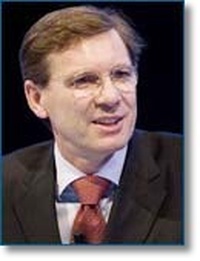Taming the Knee-Jerk
16 years, 6 months ago
(Comments)
How Philips is changing perceptions of what the business is all about. By Gerd Götz.
Let’s start with a quick Word Association test.
I say a brand, you say the first adjective and noun that you think a consumer would automatically say.
“Coca Cola.”
“Toyota.”
“Google.”
Let’s open the envelope and see the results.
Well, no surprises there. “Refreshing drink.” “Great cars.” “Fast search-engine.” Or various close approximations, anyway.
Now try this one.
“Philips.”
No envelope here. More of a postal sack, if truth be told.
“Smart TVs”. “Electric shavers.” “Long-lasting light-bulbs.” “3-D scanners.” “White goods”. Even “intimate massagers”.
Well, apart from the white goods which we exited years ago, all those are true. And a lot more besides.
For Philips, a global brand categorized by Interbrand as merely ‘Diversified’, explaining what we do effectively and comprehensively has always been our big communications challenge.
Answering the dreaded questions
In common with many old-established businesses that expanded widely from their first product, we have long sought a brief and cogent answer to that dreaded question: What makes you different? Or, worse still, what difference do you make?
After much debate, we found the answer to both: Philips is a Health and Well-being company. All the things that we design, market and acquire have something in common: What they do and how they do it focuses on helping people feel better within themselves and about themselves.
Working with our ‘sense and simplicity’ brand positioning, the ambition is to establish Philips as the leading brand in Health and Well-being. As it happens, the PR challenge is not one of explanation; it’s actually pretty easy to make the case. No, the great conundrum is to convince people to look at the business in a new way, even as we continue to market and develop the products for which we are famous.
Now, the annals of research into our industry are not exactly over-flowing with case studies in this area, as far as I know. There are plenty on rebranding, and as many on rescuing reputations from disaster.
But there are few, if any, on the wholesale repositioning of a business that is number one in many of its markets and a household name across the globe. And even if there were, I’m not sure how helpful they’d be. After all, every business is unique within itself.
The marathon solution
When you aspire to profound and sustainable change of perception, you need to be like a marathon runner: single-minded, focused on your ultimate goal ... and possessed of great stamina.
Our first step was to set out the goal: To become the leading brand in Health and Well-being. We did this in our Vision 2010 manifesto, a single-page communication cascaded throughout the company and into key stakeholder engagements, such as analyst meetings, executive speeches and high profile interviews. It permeates every level of communications, from the boilerplate up.
The secret is to bang the drum at every opportunity: product launch, financial results or new acquisition. And we know from our media coverage and the reaction from financial analysts that it is beginning to work. Key stakeholders are looking at Philips differently.
Since Philips launched its new Sense and Simplicity brand promise in 2004, we have invested heavily in advertising and the future-gazing Simplicity Event.
These investments are now being successfully fused with our new ambition. The products and services that provide the narrative hooks in our ads and at the Simplicity Event are increasingly focused on Health and Well-being.
Staying the Course
In the business world, you need to be flexible and responsive. Any number of events can erupt to distract attention or derail strategies. So it’s the question of stamina that will be the key factor in whether we succeed in transforming perceptions of the business.
When we first worked on our Vision 2010, the credit crunch was only a glimmer in the eye of those with 20/20 foresight. Over a year in to the greatest crisis to threaten our global markets for eight decades, there is no end in view.
So, even as Philips – in common with every other business – prepares to tighten its belt, we must keep a firm focus on our goal.
That requires the company to stay on the road that it has set itself, even when it might be tempting to slip into a lay-by for a quick rest. As budgets come under increasing pressure, it is the communications champion who must remind waverers of the rightness of the strategy and of the prize that waits at the end of the journey.
And for us, that prize is great. It is to seize ownership of a fast-developing sector so that, in a Word Association test in two years, when I say ‘Philips’, your knee-jerk reply will be: ‘Health and Well-being’, preceded by adjectives like ‘Innovative’, ‘Simple’ and ‘Trusted’.

The Author
Gerd Götz
Gerd Götz, Vice President, Deputy Global Director Corporate Communications, Royal Philips Electronics.
mail the authorvisit the author's website
Forward, Post, Comment | #IpraITL
We are keen for our IPRA Thought Leadership essays to stimulate debate. With that objective in mind, we encourage readers to participate in and facilitate discussion. Please forward essay links to your industry contacts, post them to blogs, websites and social networking sites and above all give us your feedback via forums such as IPRA’s LinkedIn group. A new ITL essay is published on the IPRA website every week. Prospective ITL essay contributors should send a short synopsis to IPRA head of editorial content Rob Gray emailShare on Twitter Share on Facebook


Comments